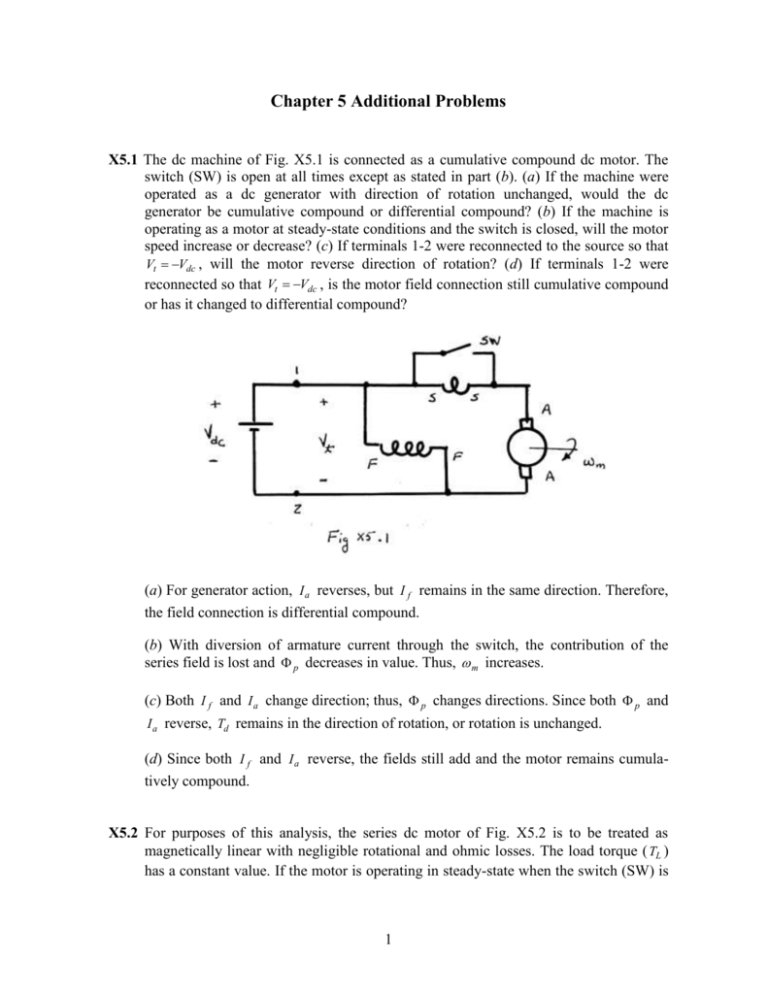Chapter 5 Additional Problems
advertisement

Chapter 5 Additional Problems X5.1 The dc machine of Fig. X5.1 is connected as a cumulative compound dc motor. The switch (SW) is open at all times except as stated in part (b). (a) If the machine were operated as a dc generator with direction of rotation unchanged, would the dc generator be cumulative compound or differential compound? (b) If the machine is operating as a motor at steady-state conditions and the switch is closed, will the motor speed increase or decrease? (c) If terminals 1-2 were reconnected to the source so that Vt Vdc , will the motor reverse direction of rotation? (d) If terminals 1-2 were reconnected so that Vt Vdc , is the motor field connection still cumulative compound or has it changed to differential compound? (a) For generator action, I a reverses, but I f remains in the same direction. Therefore, the field connection is differential compound. (b) With diversion of armature current through the switch, the contribution of the series field is lost and p decreases in value. Thus, m increases. (c) Both I f and I a change direction; thus, p changes directions. Since both p and I a reverse, Td remains in the direction of rotation, or rotation is unchanged. (d) Since both I f and I a reverse, the fields still add and the motor remains cumulatively compound. X5.2 For purposes of this analysis, the series dc motor of Fig. X5.2 is to be treated as magnetically linear with negligible rotational and ohmic losses. The load torque ( TL ) has a constant value. If the motor is operating in steady-state when the switch (SW) is 1 moved from position 1 to position 2, (a) predict the new motor current and (b) the new motor steady-state speed, both as a percentage of the prior quantities. (a) By [5.15], Td K I a2 C1 Thus, I a does not change from the prior value. (b) By [5.10] and [5.13], m Vt Vt K p KC I a Since I a is constant, m2 2VB 2 m1 VB The new speed is 200% of the prior speed. X5.3 Rework Problem X5.2 except let TL kT m2 and all else is unchanged. (a) Using [5.15], TL Td kT m2 K I a2 Thus, m C1I a (1) Based on [5.10], m Vt Vt K p KC I a (2) 2 Equate (1) and (2) to see that I a C2 Vt Thus, I a 2 C2 2VB 2 I a1 C2 VB The current increases to 141% of the prior value. (b) Based on (1), m 2 C1I a 2 C1 2 I a1 2 m1 C1I a1 C1I a1 The speed also increases to 141% of the prior value. X5.4 For purposes of analysis, the shunt dc motor of Fig. X5.3 is to be treated as magnetically linear with negligible rotational losses and ohmic losses. The load torque ( TL ) has a constant value. If the motor is operating in steady-state when the switch (SW) is moved from position 1 to position 2, (a) predict the new motor current and (b) the new motor speed, both as a percentage of prior quantities. (a) For magnetic linearity, p K I f KVt (1) Rf Equating load and developed torque and using (1), KVt TL C1 Td K p I a K Rf Thus, C2 2VB I a 2 C2 VB I a1 I a C2Vt I a 2I a 2 1 I a1 Armature current decreases to half of the prior value. 3 (b) Based on [5.10] and using (1), m Vt K p Vt KVt K Rf Rf K K Speed is independent of Vt , or speed is unchanged. X5.5 Rework Problem X5.4 except let TL kT m2 and all else is unchanged. The solution is more simple if part (b) is solved before part (a). (b) For magnetic linearity, p K I f KVt (1) Rf Based on [5.10] and using (1), m Vt K p Vt KVt K Rf Rf K K Speed is independent of Vt , or speed is unchanged. (a) By equating load and developed torque and using (1), KVt TL Td kT m2 K p I a K Rf I a or m2 CVt I a Since speed is constant, I a 2 Vt1 VB 1 I a1 Vt 2 2VB 2 The armature current changes to 50% of the prior value. X5.6 The separately-excited dc motor of Fig. X5.4 was operated at no-load and the following data were recorded: m 1000 /30 rad / s I a 0.95 A Vt 240 V VB 150 V The field voltage ( VB ) is unchanged, but the motor is loaded so that it supplies an output power Ps 10 HP at 1000 rpm to a coupled mechanical load. At this load point, determine (a) the rotational losses, (b) the armature current, (c) the terminal voltage, and (d) the efficiency. Neglect armature reaction. 4 (a) Since the speed is unchanged, PFW can be found from the no-load data. PFW Vt I a I a2 Ra 240 0.95 0.95 0.2 227.8 W 2 (b) For the no-load condition, E Vt I a Ra 240 0.95 0.2 239.81 V Then, K p E m 239.81 2.29 V s / rad 1000 / 30 The developed torque at the load point is Td Pd m Ps PFW m 10 746 227.8 73.41 N m 1000 / 30 Thus, Ia Td 73.41 32.06 A K p 2.29 (c) The load point terminal voltage is Vt E I a Ra 239.81 32.06 0.2 246.22 V (d) The total losses are 150 733.37 W VB2 2 227.8 32.06 0.2 Rf 75 2 Losses PFW I a2 Ra Ps 100 Ps losses 10 746 100 91.05% 10 746 733.37 5 X5.7 A 230 V dc machine has an emf constant K 212.21 V ´s / Wb rad and Ra 0.278 . The field is separately excited and produces 0.01 Wb per pole. I a 36 A for all parts of the problem. (a) At what speed does the machine operate as a dc generator with rated terminal voltage? (b) At what speed does the machine operate as a dc motor with rated terminal voltage? (c) If an external resistance Rx 1 is added in series with the armature circuit, at what speed does the machine operate as a dc motor with rated terminal voltage? (d) If the motor of part (b) is known to be supplying 10 HP to a coupled mechanical load, determine the rotational losses at the point of operation. (a) E Vt I a Ra 230 36 0.278 240 V m E 240 113.09 rad/s 1080 rpm K p 212.21 0.01 m 230 36 0.278 V I R E t a a 103.67 rad/s 990 rpm K p K p 212.21 0.01 (b) (c) m (d) Vt I a Ra Rx K p 230 36 0.278 1 212.21 0.01 86.7 rad/s 828 rpm Pd EI a Vt I a Ra I a 230 36 0.2728 36 7919.7 W PFW Pd Ps 7919.7 10 746 459.7 W X5.8 A series dc motor that can be treated as magnetically linear is operating at 1200 rpm with Vt 250 V and I a 50 A . It is known that Ra Rs 0.2 . If torque is increased until the speed is reduced to 750 rpm while Vt remains constant in value, determine the new values for Td and I a . Let 1 denote the 1200 rpm case and 2 denote the 750 rpm case. E1 Vt I a1 Ra Rs 250 50 0.2 240 V Based on [5.14], K E1 I a1 m1 240 Vs 0.0382 50 1200 / 30 A rad E2 K I a 2m 2 Vt I a 2 Ra Rs 6 Whence, Ia2 Vt 230 73.01 A K m 2 Ra RS 0.0382 750 / 30 0.2 By [5.15], Td 2 K I a22 0.0382 73.01 230.62 N m 2 X5.9 A shunt dc motor draws an input current I L 75 A while driving a coupled mechanical load at a speed of m 1000 / 30 rad/s . Efficiency at the point of operation is known to be 92%. Also, Ra 0.1 and R f 200 . (a) Calculate the value of output power to the mechanical load. (b) Determine the value of rotational losses at the point of operation. (c) Find the value of developed torque. (a) Ps 100 Pin 100 Vt I L 92 250 75 17,250 W 100 (b) Ia IL Vt 250 75 73.75 A Rf 200 PFW Vt I L Ps Vt 2 I a2 Ra Rf PFW 250 75 17, 250 250 2 200 73.75 0.1 643.6 W (c) Td Ps PFW m 17,250 643.6 170.87 N m 1000 / 30 X5.10 The magnetically linear, separately-excited dc motor of Fig. X5.5 has negligible rotational losses and drives a constant torque coupled mechanical load. The motor is operating at steady-state conditions. Assume that Vt I a Ra . The switch is moved from position 1 to position 2. Determine the percentage change in motor speed and armature current from the initial operating condition. 7 Let 1 denote the initial operating point and 2 denote the new operating point. By [5.10], m1 VB K p1 m2 VB VB 2VB 1 K p 2 K 2 p1 K p1 Thus, speed doubles, or the new speed is 200% of the initial speed. Since TL is constant and TFW 0 , Td 2 Td 1 . K p2 Ia2 K 12 p1 I a 2 K p1I a1 Thus, I a 2 2 I a1 The armature current doubles, or the new armature current is 200% of the initial armature current. X5.11 Rework Problem X5.10 except that the coupled mechanical load torque is described by TL kT m . The determination of speed follows the identical procedure of Problem X5.10 so that the new speed is 200% of the initial speed. Ratio of torques with TFW 0 gives Td 2 TL 2 kT m2 2 Td1 TL1 kT m1 8 Hence, Td 2 2Td 1 K p2 Ia2 K 12 p1 I a2 2K p1Ia1 or I a 2 4 I a1 The new value of armature current is 400% of the initial value of armature current. X5.12 A shunt dc motor has the OCC of Fig. 5.59. Vt 250 V and I f 1.35 A . The motor is operating at 1200 rpm while supplying 25 HP to a coupled mechanical load. At the point of operation, the rotational losses are 550 W. (a) Determine the value of developed torque. (b) Calculate the value of armature current. (c) Find the value of armature resistance. (d) Determine the value of efficiency at the point of operation. (a) Pd Ps PFW 25 746 550 19,200 W Td Pd m 19,200 152.79 N m 1200 / 30 (b) From Fig. 5.59 for I f 1.35 , E 235 V . Ia Pd 19,200 81.7 A E 235 Ra Vt E 250 235 0.1836 Ia 81.7 (c) (d) Ps 100% Vt I L 25 746100% 89.83% 25081.7 1.35 X5.13 For the shunt dc motor of Problem X5.12, the mechanical load torque is increased so that the speed is reduced from 1200 rpm to 1150 rpm. Vt and I f are unchanged. Determine the values of (a) motor line current and (b) output power if it is known that rotational losses vary as speed squared. (a) Since field current is unchanged, E 1150 235 225.2 V 1200 Ia Vt E 250 225.2 135.08 A Ra 0.1836 9 (b) Ps Pd PFW E I a PFW 2 1150 Ps 225.2 135.08 550 30,925.1 W 41.45 HP 1200 X5.14 The OCC for the separately excited dc generator of Fig. X5.6 is given by Fig. 5.59. (a) If I f 1 A , m 1500 / 30 rad/s , and the switch SW is open, find Vt . (b) If I f 1.5 A , m 1200 / 30 rad/s , and the switch is closed, determine the value of I a . (c) If the generator is operating as described in part (b) with PFW 400 W , calculate the input mechanical power. (a) From Fig. 5.59 with I f 1 A , E 190 V at 1200 rpm. Adjust to 1500 rpm and note that I a 0 . Vt E 1500 190 237.5 V 1200 (b) Enter Fig. 5.59 with I f 1.5 A to find E 242 V at 1200 rpm. By KVL, Ia (c) E 242 23.27 A Ra RL 0.4 10 Pin PFW EI a 400 242 23.27 6031.3 W X5.15 A shunt dc motor is fed from a 250 V dc bus. The motor is operating at 1200 rpm supplying 30 HP to a coupled mechanical load. From an ammeter reading, the line 10 current to the motor is 102 A. It is known that Ra 0.2 and R f 125 . Determine (a) the value of rotational losses and (b) the efficiency. (a) Ia I L Vf Rf 102 250 100 A 125 E Vt I a Ra 250 100 0.2 230 V Pd EI a 230100 23,000 W PFW Pd Ps 23,000 30 746 620 W (b) Ps 100% Vt I L 30 746100% 87.76% 250102 X5.16 A shunt dc motor nameplate has the data 230 V, 1350 rpm, 10 HP, and 37.5 A. In addition, it is known that Ra 0.35 , rated speed rotational losses are 519 W , and field current is 0.75 A at rated conditions. (a) Determine developed torque, the CEMF, and efficiency at rated conditions. (b) If the motor is operating at rated conditions when the load torque is reduced until the line current drops to 20 A, calculate the new speed and developed torque. (a) Td Ps PFW m 10 746 519 56.44 N m 1350 / 30 I a I L I f 37.5 0.75 36.75 A E Vt I a Ra 230 36.75 0.35 217.14 V 10 746 100% 86.49% Ps 100% Vt I L 230 37.5 (b) Since I f is unchanged, p is unchanged. Let R denote rated condition. I a I L I f 20 0.75 19.25 A E Vt I a Ra 230 19.25 0.35 223.26 V nm E 223.26 nmR 1350 1388.1 rpm ER 217.14 Td Ia 19.25 TdR 56.44 29.56 N m I aR 36.75 11 X5.17 In test of large dc machines, a suitable load may not be available for full power operation. Frequently, a back-to-back test using two identical machines is used, as shown schematically by Fig. X5.7 where one machine acts as a motor (M) to drive the other machine as a generator (G). The shafts of the two machines are mechanically coupled. An auxiliary dc source ( VB ) is used to supply all losses (except field winding losses). Assume that rotational losses are negligible so that the losses supplied by VB 2 2 are I B2 RB I aG I am Ra . Both fields are separately excited; however, G 1.05 M . It is known that EG 750 V when m 100 rad/s . It turns out that VB must vary directly with speed to maintain operation. Determine the value of the ratio VB / m for this particular set-up. K G EG m 750 7.5 100 The motor and generator developed torques are equal. K G I aG K 1.05 M I aG K M I aM or I aM 1.05 I aG (1) By KVL, EG EM K Gm K mm I aG I aM Ra (2) Substitute G 1.05 M , (1), and Ra 0.05 into (2) to find m 0.287 I aG (3) By KCL and subsequent substitution of (1), I B I aM I aG 1.05 I aG I aG 0.05 I aG 12 (4) Since VB supplies the losses other than field losses, 2 2 VB I B I B2 RB I aG I aM Ra (5) Use (1), (4), and Ra 0.05 in (5) to yield VB 2.1075 I aG (6) Ratio (6) and (3) to give VB m 2.1075 I aG Vs 7.3432 0.287 I aG rad 13






